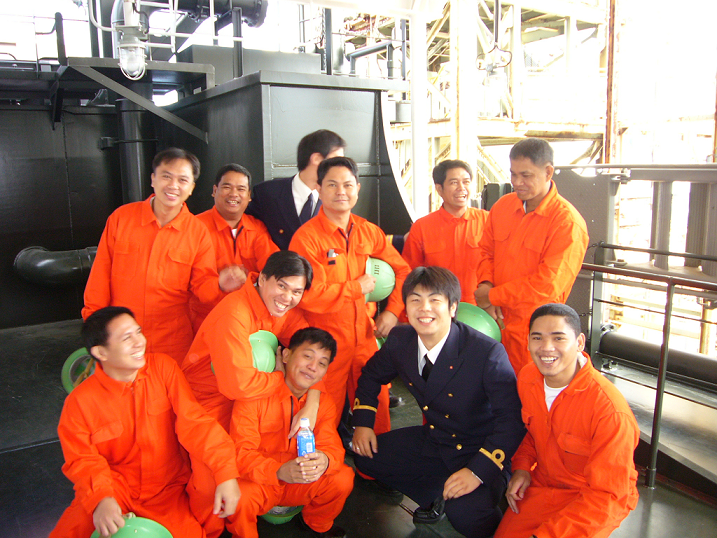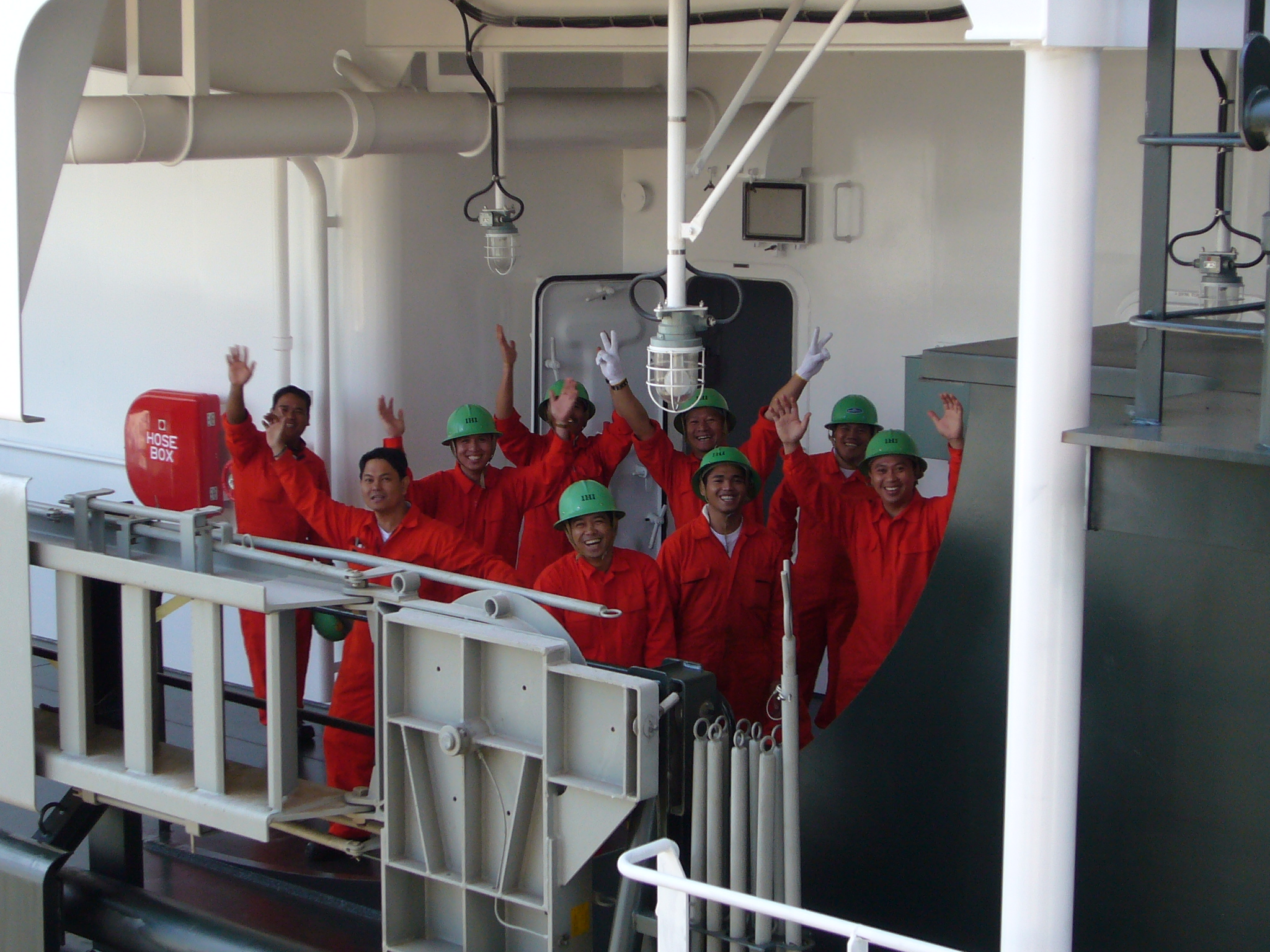Home ||
Tanker Safety ||
Container Ship Handling ||
Commercial Management ||
EMS
Container ship operation : ensuring safety of personnel
Containership operations are personnel intensive. Although over the years, the transition from general cargo to containerized cargo and from non standard vessels to standard cellular container vessels has reduced manpower requirements on board.
In port stevedores board the vessel for lashing, unlashing and cargo operations and their safety whilst on board is the vessels responsibility. It is important to understand that any injury caused to stevedores or shore personnel due to a condition on board being unsafe, can result in very large claims to the vessel.
On board containerships there are several potential safety hazards in the cargo working area and these will have to be identified, made safe and monitored to ensure continued safety.
All obstructions/protrusions on deck must be Marked / Highlighted, safety rails / guard rails, walkways, ladders, handholds etc must be maintained in good condition and safety ropes/nets must be rigged where necessary.
Personnel should not be near / under objects like Containers, Hatch covers etc then these are moving overhead.
When hatch covers are closed, forced ventilation must be operated for a suitable period of time before man entry into cargo holds.
Safe access to and from the vessel, its cargo working areas and cargo holds must be provided and maintained at all times. All cargo working areas and accesses must be adequately illuminated.
Related article
Ships crew familiarization training onboard
Job specific training onboard
Our additional pages contain somewhat larger lists of resources where you can find useful informations
- Containership operation : Cargo Securing
There are six degrees of motion at sea that a ship may have to encounter in a voyage. However, pitching, heaving, and rolling are three major forces that impact most on a containership's lashing arrangement. Lateral rolling motion factors the greatest challenge for piles of containers. If containers are to be carried safely on the deck of a container vessel, they must be tightly connected to the ship. It is done with the aid of devices known as twist locks.
.....
- Containership operation : Common reasons for stowfall
Container stows often fail due to container stacks being too heavy and too high overall, exposing the lower containers to excessive transverse racking and compressive forces due to the tipping effect. Such an anomaly may occur if the ship is unable to calculate the forces acting on stow with precision. The Cargo/Container Securing Manual is limited in this respect as the examples of container weight distributions shown may not cover all permutations and eventualities. Software programs have the advantage of taking into account all known variables........
- Containership operation: Cargo hold ventilation
Cargo holds ventilation onboard a containership is very important as it minimizes the risk of harm or damage to cargo. A proper ventilation system assures the quality of the transported goods by preventing the formation of condensation in cargo spaces, reducing the harmful heating of the shipment, and removing potential hazardous gases from cargo spaces........
- Containership operation: Safety of personnel
In port stevedores board the vessel for lashing, unlashing and cargo operations and their safety whilst on board is the vessels responsibility. It is important to understand that any injury caused to stevedores or shore personnel due to a condition on board being unsafe, can result in very large claims to the vessel.
.....
- Containership operation: wet damage in cargo hold
When water entered into a ship's cargo, hold it may cause wet damage to the cargo inside containers especially to those stowed on the bottom stack, unless the bilge water is drained in a proper and swift manner. The regular sounding of bilge well or monitoring bilge alarm must be one of the very important or rather essential routine jobs on board. However, this job requires special attention on board. All bilge alarm need to be tested regularly......
- Reefer cargo care at sea
Unlike permanent cold stores or refrigerated ships, where robust equipment is under constant care by qualified personnel, the ISO refrigerated container may travel by several different modes and be in the care of many and varied people. Before being despatched to load refrigerated cargo (usually at shippers' premises), the container and its machinery should be subjected to a rigorous examination.......
- Containership cargo stowage and planning
Master and officers of all vessels require a good working knowledge of the various kinds of cargo they are likely to carry their peculiar characteristics, liability to damage, decay, or deterioration, their measurement, and the usual methods of packing, loading and discharging, stowage, dunnage, etc., as the Master is responsible for the safe loading of his vessel and the proper storage of the cargo......
- Stacking Weights Restrictions
rior loading cargo, stacking weights of containers must be checked against the allowable stack weights on board the vessel both on deck and under deck. Neglecting above may cause serious damage to ships structure, hull and eventually overall stabilty of ship may get affected. Maximum allowable stack weights of Tank tops, Hatch covers and Decks shall not be exceeded at any time......
- Lashing strength calculation
Lashing strength of deck cargo shall be ascertained by using the appropriate lashing strength calculation software where provided. All resulting values for lashing strength must be within the tolerance limits prescribed by the vessels classification society......
- Dangerous goods stowage and segregation
Clear guidelines apply to the stowage and segregation of Dangerous Goods and in some cases may require particular commodities to be carried in completely separate holds. The interaction of two cargoes will not occur if the packaging of that cargo remains intact. However, the Master must always consider the possible effect should the cargo escape for any reason and should not restrict his consideration to those cargoes which are listed in the IMDG Code......
- Reefer Container Stowage
Reefer containers proposed for stowage must be accompanied by a reefer manifest. This reefer manifest should contain Container No., Stow position, Commodity, Temperature, and Ventilation status......
- Out of Gauge Container Stowage
It is essential that, during out of gauge cargo operations, a careful watch is kept for any damage caused to the vessel, her equipment, or to containers. Notice of any damage must be immediately brought to the attention of the Stevedore's representative, the Port Captain/Supercargo and Charterers Agent. Damage reports must be completed in all cases giving the full and comprehensive details of damage caused......
- Special Container Stowage
After receiving stowage plan ships, Chief Officer must ensure that all Deck Officers are aware of any specialized containers due to be worked, such as reefers, vents, over-heights, over-widths, flat racks, etc. and their unique requirements.....
- 20 or 40 or 45 feet Compulsory Stowage Locations
Most cargo securing manual provide a guideline for different container types. These stow positions of 20 feet,40 feet, or 45 feet are also incorporated in a ship-specific stowage planning software and highlight errors if any violations occur......
- Irregular Stowage of Containers
The Terminal Planner shall present the pre-loading plan to the Chief Officer to obtain his approval/comments. The Chief Officer, in turn, enters the cargo data in the loading computer and must ensure that the required criteria, concerning stack weights, trim/stability/stresses/ visibility limitations, DG cargo segregation, and specialized container requirements, are met. He should allow the bunker/freshwater consumption during the voyage and all possibilities of ballasting / deballasting. The completed loading plan must be presented to the ship's Master for approval.....
- Over-stow of Containers
With a closed roof, the hardtop the container offers the same reliable protection as provided by a standard box. Hardtop containers have more lashing points than other container types. This guaran- tees reliable and convenient securing of cargo.
.....
- Hatch Cover Clearance (High cube containers Under Deck )
Hatch cover clearance must be checked carefully in case of loading over height containers or high cube containers underdeck......
- Other matters regarding cargo stowage as necessary
Bulk products carried in a closed container might include malt, grain, seed, polythene granules, chemically inert powders, brake fluid, detergent, fruit juice, wine, non-hazardous oils, sodium silicate, fatty acids and maple syrup amongst many others......
NOTE:
Shipsbusiness.com is a reference site to help people searching for ships business . This site is merely an informational site about various aspects of ships operation,maintenance , onboard procedures and latest development in modern shipping industry. User feedback is extremely important to update our database.For any comments or suggestions please contact us Support"shipsbusiness.com.

Other Info Pages
Home Our home page
Container Ship Operation Basic guidance
Cargo stowage and planning How to plan effctively
Cargo care at sea Precautions to be taken
Reefer cargo handling Troubleshoot and countermeasures
DG cargo handling Procedures & Guidelines
Cargo securing Check items prior departure port
Safe navigation Various factors affecting ships navigation at sea
Hull strength & stability Prior loading how to ensure hull strength & stability of ship
Site Map Page listing for this site.
Site Use and Privacy - Read our privacy policy and site use information.
Copyright © Ships business.com All rights reserved.
How to deal when a person is death
Measures to protect the vessel side against stevedores injury
What are the safe navigational procedure for the officer of the watch ?
....
How to give treatment to injured persons onboard ?
....
What is Peril at Sea and Salvage?
....


